
The .338 Lapua Magnum is a Finnish rimless, bottlenecked, centerfire rifle cartridge. It was developed during the 1980s as a high-powered, long-range cartridge for military snipers. Due to its use in the War in Afghanistan and the Iraq War, the cartridge has become widely available.

This is a list of firearm cartridges which have bullets of a caliber between 6 millimetres (0.236 in) and 6.99 millimetres (0.275 in).
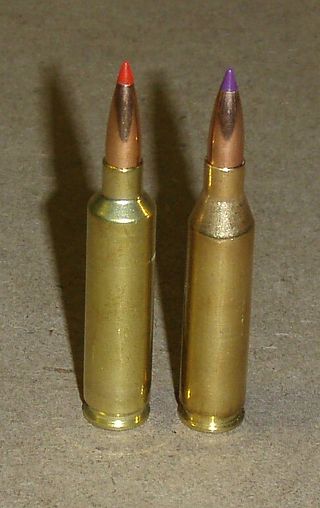
A wildcat cartridge, often shortened to wildcat, is a custom-made cartridge for which ammunition and/or firearms are not mass-produced. These cartridges are often created as experimental variants to optimize a certain ballistic performance characteristic of an existing commercial cartridge, or may merely be intended as novelty items.
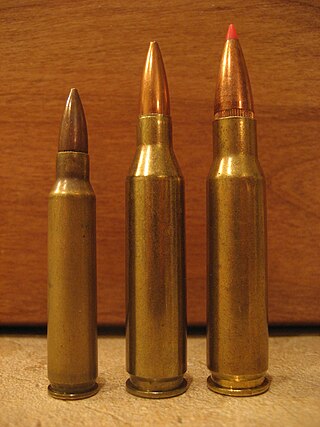
The .243 Winchester (6×52mm) is a popular sporting rifle cartridge. Developed as a versatile short action cartridge to hunt both medium game and small game alike, it "took whitetail hunting by storm" when introduced in 1955, and remains one of the most popular whitetail deer cartridges. It is also commonly used for harvesting blacktail deer, pronghorns and mule deer with heavier rounds, and is equally suited to varmint hunting with lighter rounds. The .243 is based on a necked down .308 Winchester, introduced only three years earlier. Expanding monolithic copper bullets of approximately 80 to 85 grains or traditional lead rounds of 90 to 105 grains with controlled expansion designs are best suited for hunting medium game, while lighter rounds are intended for varmints.

Benchrest shooting is a shooting sport discipline in which high-precision rifles are rested on a table or bench – rather than being carried in the shooter's hands – while shooting at paper or steel targets, hence the name "benchrest". Both the forearm and buttstock of such a rifle are usually fully supported by bean bags, a bipod/monopod (front/rear) combination, and/or a specially designed fixture device called shooting rest, so that the gun can remain stably pointing at the target without needing to be held by someone. When shooting, the shooter simply sits/stands comfortably behind the table/bench, operates the action and pulls the trigger, without needing to worry about carrying any weight of the gun. This is in contrast to other shooting disciplines, where the shooter has to bear at least part of the gun's weight while holding it steady to aim, even when using support devices such as bipods, tripods or shooting sticks.
The .204 Ruger / 5.2x47mm is a centerfire rifle cartridge developed by Hornady and Ruger. At the time of its introduction in 2004, the .204 Ruger was the second-highest velocity commercially produced ammunition and the only centerfire cartridge produced commercially for bullets of .204 inch/5 mm caliber.

The 6mm PPC, or 6x38 PPC as it is more often called, is a centerfire rifle cartridge used almost exclusively for benchrest shooting. It is one of the most accurate cartridges available at distances of up to 300 meters. This cartridge's accuracy is produced by a combination of its stout posture, being only 31 mm (1.22 in) long, and aggressive shoulder angle of 30 degrees. Its primary use has been benchrest shooting matches since the 1980s.
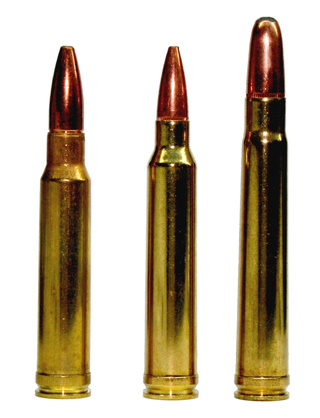
The .300 Winchester Magnum is a belted, bottlenecked magnum rifle cartridge that was introduced by the Winchester Repeating Arms Company in 1963. The .300 Winchester Magnum is a magnum cartridge designed to fit in a standard rifle action. It is based on the .375 H&H Magnum, which has been blown out, shortened, and necked down to accept a .30 caliber (7.62 mm) bullet.

The .222 Remington or 5.7×43mm (C.I.P), also known as the triple deuce, triple two, and treble two, is a centerfire rifle cartridge. Introduced in 1950, it was the first commercial rimless .22 (5.56 mm) cartridge made in the United States. As such, it was an entirely new design, without a parent case. The .222 Remington was a popular target cartridge from its introduction until the mid-1970s and still enjoys a reputation for accuracy. It remains a popular vermin or "varmint" cartridge at short and medium ranges with preferred bullet weights of 40–55 grains and muzzle velocities from 3,000 to 3,500 ft/s (915–1,067 m/s).

The 6mm Remington rifle cartridge, originally introduced in 1955 by Remington Arms Company as the .244 Remington, is based on a necked down .257 Roberts cartridge using a .24/6mm bullet. Known for a combination of high velocity, long range, flat trajectory, and accuracy, it is suitable as a dual use hunting cartridge for both medium-sized big game and varmints. When used in the less common earlier slow twist barrels, it offers exceptional range for varmint applications. While not as commercially popular today as the .243 Winchester, the 6mm Remington enjoys a slight ballistic advantage and continues to be popular with handloaders and custom rifle builders.
The 6.5×47mm Lapua is a smokeless powder rimless bottlenecked rifle cartridge that was developed specifically for 300–1,000 m (328–1,094 yd) competition shooting by ammunition maker Nammo Lapua and the Swiss rifle manufacturer Grünig & Elmiger AG in 2005. Other common names for this cartridge include 6.5×47mm.
The .260 Remington cartridge was introduced by Remington in 1997. Many wildcat cartridges based on the .308 Winchester case had existed for years before Remington standardized this round.

The .284 Winchester (7.21x55mmRB) is a rebated rim firearm cartridge, introduced by Winchester in 1963.
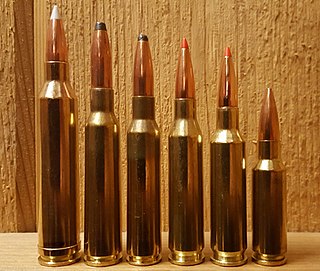
The 6.5mm Creedmoor (6.5×48mm), designated 6.5 Creedmoor by SAAMI, 6,5 Creedmoor by the C.I.P. is a centerfire rifle cartridge introduced by Hornady in 2007. It was developed by Hornady senior ballistics scientist Dave Emary in partnership with Dennis DeMille, the vice-president of product development at Creedmoor Sports, hence the name. The cartridge is a necked-down modification of the .30 Thompson Center.
The .22 PPC / 5.7x38mm is a centerfire rifle cartridge developed in 1974 by Dr. Louis Palmisano and Ferris Pindell, primarily as a benchrest cartridge. The cartridge is based on the 5.6×39mm case which is a necked-down version of the 7.62×39mm Soviet military cartridge. Several companies have made custom guns in this caliber, however no major companies did until 1993, when Ruger announced their No. 1 V and M77 varmint rifles in this caliber.
The 6×45mm is a rimless, bottlenecked cartridge based on the .223 Remington or 5.56 NATO cartridge necked up to .243 (6mm). The cartridge is also known as the 6mm-223 Remington or 6mm/223.

The 6mm BR / 6.2x39mm is a centerfire cartridge created for benchrest shooting. The cartridge is also known as the 6mm Bench Rest or simply 6 BR, and has also developed a following among varmint hunters because of its efficiency. There are two basic variants of very similar dimensions, known as the 6mm BR Remington and the 6mm Norma BR.
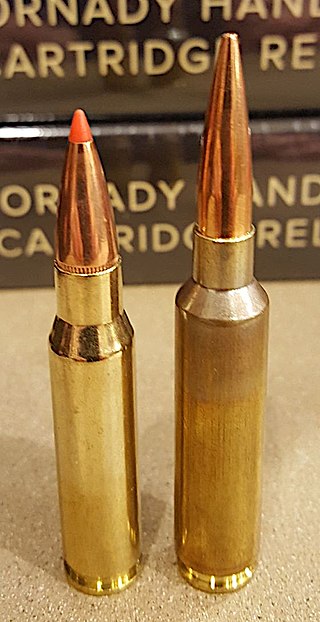
The 6.5-284 Norma originated as a wildcat cartridge based on the .284 Winchester cartridge necked down to 6.5 mm.
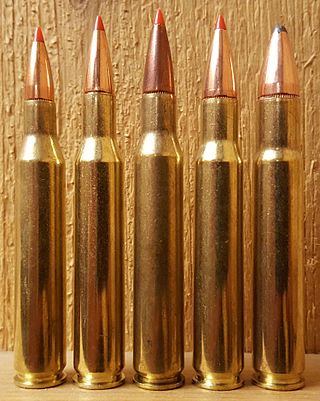
.30-06 Springfield wildcat cartridges are cartridges developed from a 30-06 Springfield "parent cartridge" through narrowing or widening the cartridge neck to fit a smaller or larger bullet in an attempt to improve performance in specific areas. Such wildcat cartridges are not standardized with recognized small arms standardization bodies like the SAAMI and the CIP.
The 7mm BR Remington / 7.2x38mm, commonly called the 7mm BR or the 7mm Benchrest Remington in long form, was an intermediate cartridge developed by Remington for the Remington XP-100 single-shot bolt-action handgun. The cartridge was developed for the Unlimited Class in the sport of Metallic silhouette shooting. Later it was introduced in the Remington Model XB-40 single-shot bolt-action rifle, which was specifically designed for the benchrest shooting community.













